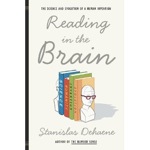
SCIENTIFIC AMERICAN: [I]f the brain of a dyslexic is organized differently, does that suggest that it might have other abilities – or is dyslexia purely an impairment?
DEHAENE: This isn’t fully known, but I was intrigued by recent research which indicates that dyslexic children and adults can be better on tasks of symmetry detection – they have a greater ability to notice the presence of symmetrical patterns, and the evidence even suggests that this was helpful in a group of astrophysicists to detect the symmetrical spectrum of black holes!
My theory is that mirror recognition is one of the functions that we have to partially ‘un-learn’ when we learn to read – it is a universal feature of the primate brain that is, unfortunately, inappropriate in our alphabet where letters p, q, d and b abound. By somehow managing to maintain this ability, dyslexics might be at some advantage in visual, spatial or even mathematical tasks.
More generally, we are touching here on the very interesting issue of whether cultural recycling makes us lose some abilities that were once useful in our evolution. The brain is a finite system, so although there are overwhelming benefits of education, there might also be some losses.
“a rectangular arrangement of keys…in alphabetical order. The levers manipulated by the keys were large and ungainly, and the size, spacing, and arrangement of the keys were dictated by these mechanical considerations, not by the characteristics of the human hand…Why did the alphabetical ordering change? To overcome a mechanical problem. When the typist went too quickly the typebars would collide, jamming the mechanism. The solution was to change the locations of the keys: letters such as i and e that were often typed in succession were placed on opposite sides of the machine so that their bars would not collide…In the end, the keyboard was designed through an evolutionary process, but the main driving forces were mechanical. Modern keyboards do not have the same problems; jamming isn’t a possibility with electronic keyboards and computers…In the end, the qwerty keyboard was adopted throughout the world with but minor variations. We are committed to it, even though it was designed to satisfy constraints that no longer apply…and [it] is difficult to learn…There is a better way – the Dvorak keyboard…It is easier to learn and allows for about 10 percent faster typing, but that is simply not enough of an improvement to merit a revolution in the keyboard. Millions of people would have to learn a new style of typing. Millions of typewriters would have to be changed. The severe constraints of existing practice prevent change, even where the change would be an improvement” (Donald Norman, The Design of Everyday Things, pp146,147,&148)
Editor’s Note: Matt Hayler is a PhD Researcher at the University of Exeter. He is interested in all forms of resistance to the digitisation of the written word, but particularly resistance stemming from human neuropsychological and phenomenological interaction with physical objects and the widespread idea that technology is ‘unnatural.’ He blogs at http://4oh4-wordsnotfound.blogspot.com and you can follow him on twitter – @cryurchin


































The keyboard array is an interesting topic . It relates to arbitrary circumstances of spelling frequency and alphabetic order. All of these, the lay of print cases, and keyboards of composing machines and typewriter/computers, relate to writing, not to reading although it is a great question as to how habituated manipulation relates to reading and to interface of hand-held devices.
For the direct connections between composition and reading you may want to look beyond spelling frequency and alphabetic order. More direct connection would be in punctuation, line length, word spacing and hyphenation. This is in the array of words, not letters. Punctuation was invented and elaborated with the advent of printing. Remnant letter ligatures crossed the transition, but it was the formalization of type sorts for such as periods and parenthesis and space material that have had a more pervasive effect across both writing and reading.
Digital technology has intensified the influence of punctuation across the writing/reading divide with innovations such as the delete key or embedded spellers or grammar check. Curiously we have not yet advanced beyond the letterpress composer’s skill at hyphenation or line justification.
Asian printing does involve type cases and keyboards of words and this was even tried in alphabetic newspaper keyboards. Visual and diagrammatic literacy also utilizes special conventions of punctuation.
But back to your point; manipulative navigation plays a role in haptics of touch screen prompting and every indication is that the visual touch keyboard will not work. So I would not be too concerned that the template of habituated keyboard skill will necessarily be a useful trope for projection of reading efficiency. Modification of linear writing/reading path could overwhelm textual comprehension.
FYI: I wrote a review of this book some months ago:
http://sacramentobookreview.com/science_nature/reading-in-the-brain-the-science-and-evolution-of-a-human-invention/